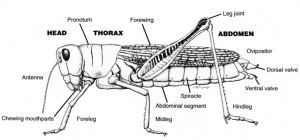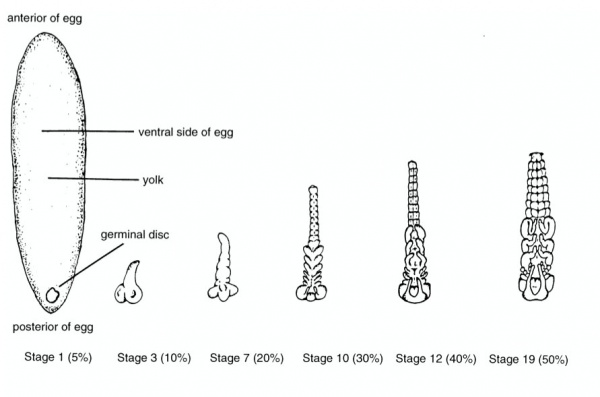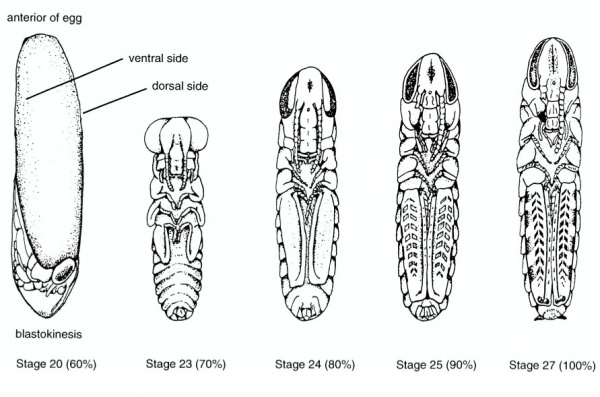Grasshopper Development
| Embryology - 27 Apr 2024 |
|---|
| Google Translate - select your language from the list shown below (this will open a new external page) |
|
العربية | català | 中文 | 中國傳統的 | français | Deutsche | עִברִית | हिंदी | bahasa Indonesia | italiano | 日本語 | 한국어 | မြန်မာ | Pilipino | Polskie | português | ਪੰਜਾਬੀ ਦੇ | Română | русский | Español | Swahili | Svensk | ไทย | Türkçe | اردو | ייִדיש | Tiếng Việt These external translations are automated and may not be accurate. (More? About Translations) |
Introduction
There is available a USDA and the Agricultural Research Service field guide that describes development in the western grasshopper.[1]
Some Recent Findings
|
| More recent papers |
|---|
|
This table allows an automated computer search of the external PubMed database using the listed "Search term" text link.
More? References | Discussion Page | Journal Searches | 2019 References | 2020 References Search term: Grasshopper Development <pubmed limit=5>Grasshopper Development</pubmed> |
Spermatogenesis
Historic drawing of stages in the spermatogenesis of a grasshopper (Stenobothrus viridulus)
Grasshopper Lifecycle
Grasshopper Development
Grasshopper Heart
Flow visualization in the heart of a grasshopper (Schistocerca americana) using synchrotron x-ray phase-contrast imaging.[4]
References
- ↑ RE. Pfadt, Field Guide to Common Western Grasshoppers 3rd edn Wyoming Agricultural Experiment Station Bulletin 912 February 2002 University of Wyoming USDA and the Agricultural Research Service - PDF
- ↑ <pubmed>25907229</pubmed>| Dev Biol.
- ↑ <pubmed>21382507</pubmed>
- ↑ <pubmed>19272159</pubmed>| BMC Physiol.
Reviews
<pubmed>12642623</pubmed> <pubmed>11112183</pubmed>
Articles
<pubmed>18590599</pubmed> <pubmed>18089112</pubmed> <pubmed>17311046</pubmed>
Search Pubmed
Search Pubmed: Grasshopper Development
Terms
- acrididae - a family of insects that comprise the grasshoppers with short antennae, short ovipositor, and tarsi of legs three-segmented.
- blastokinesis - active movement of the grasshopper embryo by which it passes from the ventral to the dorsal side of the egg and at the same time revolves 180 degrees on its long axis.
- brood - all the individuals that hatch at about one time from eggs laid by one series of parents and that normally mature at about the same time; a group of individuals of a species that have hatched into young or have become adult at approximately the same time, and live together in a defined and limited area, and they may be of different generations.
- chorionic sculpturing - a network pattern on the chorion (shell) of the insect egg.
- complete metamorphosis - metamorphosis through which the insect develops by four distinct stages: egg, larva, pupa, adult.
- diapause - a state of low metabolic activity mediated hormonally and associated with ceased growth, reduced activity, and increased resistance to environmental extremes.
- eclosion - the hatching of the larva or nymph from its egg.
- egg pod - a case made of grasshopper gluelike secretions and soil particles enclosing a clutch of grasshopper eggs.
- fledge - acquisition of the adult wings.
- gradual metamorphosis - metamorphosis through which the insect develops by three distinct stages, namely egg, nymph, adult.
- instar - the immature insect between two successive molts.
- larva - (pl., larvae) the immature insect hatched from the egg and up to the pupal stage in orders with complete metamorphosis, e.g., a caterpillar.
- metamorphosis - the change of body form through which insects pass in developing to the adult.
- nymph - an immature insect of species with gradual metamorphosis.
- ovipositor - in grasshoppers the paired digging and egg laying structures at the end of the female abdomen
- ovipositor valves - three pair of digging and egg laying structures at the end of the abdomen in female grasshoppers.
- preoviposition period - the period between molting to the adult and the laying of the first group of eggs; in grasshoppers the period normally lasts one to two weeks.
- pupa - (pl., pupae) the stage between the larva and the adult in insects with complete metamorphosis; a nonfeeding stage in which adult structures develop and grow.
- seasonal cycle - the timing of the periods of egg hatch, nymphal development, adulthood, and reproduction.
- stadium (pl., stadia) - the time period between two successive molts of larvae or nymphs.
- subgenital plate - in the male grasshopper the terminal ventral plate underlying the genitalia.
- threshold - the temperature or level of hormone concentration that must be reached before development or growth can begin.
Based on: RE. Pfadt, Field Guide to Common Western Grasshoppers 3rd edn Wyoming Agricultural Experiment Station Bulletin 912 February 2002 University of Wyoming USDA and the Agricultural Research Service - PDF
External Links
External Links Notice - The dynamic nature of the internet may mean that some of these listed links may no longer function. If the link no longer works search the web with the link text or name. Links to any external commercial sites are provided for information purposes only and should never be considered an endorsement. UNSW Embryology is provided as an educational resource with no clinical information or commercial affiliation.
- Australian Government Department of Agriculture, Fisheries and Forestry Lifecycle of a Locust
| Animal Development: axolotl | bat | cat | chicken | cow | dog | dolphin | echidna | fly | frog | goat | grasshopper | guinea pig | hamster | horse | kangaroo | koala | lizard | medaka | mouse | opossum | pig | platypus | rabbit | rat | salamander | sea squirt | sea urchin | sheep | worm | zebrafish | life cycles | development timetable | development models | K12 |
Glossary Links
- Glossary: A | B | C | D | E | F | G | H | I | J | K | L | M | N | O | P | Q | R | S | T | U | V | W | X | Y | Z | Numbers | Symbols | Term Link
Cite this page: Hill, M.A. (2024, April 27) Embryology Grasshopper Development. Retrieved from https://embryology.med.unsw.edu.au/embryology/index.php/Grasshopper_Development
- © Dr Mark Hill 2024, UNSW Embryology ISBN: 978 0 7334 2609 4 - UNSW CRICOS Provider Code No. 00098G






